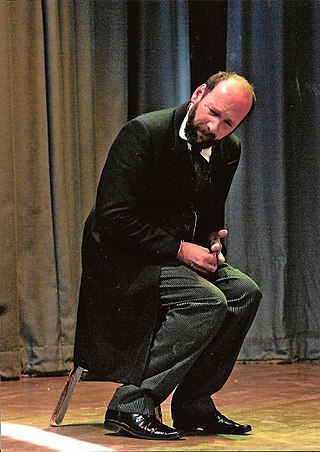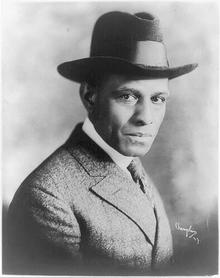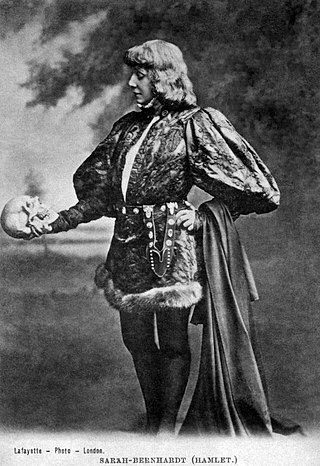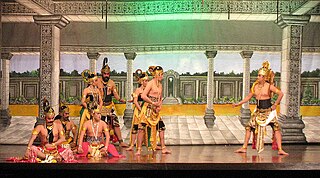
Improvisational theatre, often called improvisation or improv, is the form of theatre, often comedy, in which most or all of what is performed is unplanned or unscripted: created spontaneously by the performers. In its purest form, the dialogue, action, story, and characters are created collaboratively by the players as the improvisation unfolds in present time, without use of an already prepared, written script.

The following outline is provided as an overview of and topical guide to theatre:

Radio drama is a dramatized, purely acoustic performance. With no visual component, radio drama depends on dialogue, music and sound effects to help the listener imagine the characters and story: "It is auditory in the physical dimension but equally powerful as a visual force in the psychological dimension." Radio drama includes plays specifically written for radio, docudrama, dramatized works of fiction, as well as plays originally written for the theatre, including musical theatre, and opera.

Charles Laughton was a British-American actor. He was trained in London at the Royal Academy of Dramatic Art and first appeared professionally on the stage in 1926. In 1927, he was cast in a play with his future wife Elsa Lanchester, with whom he lived and worked until his death.

Agnes Robertson Moorehead was an American actress. In a career spanning four decades, her credits included work in radio, stage, film, and television. Moorehead was the recipient of such accolades as a Primetime Emmy Award and two Golden Globe Awards, in addition to nominations for four Academy Awards. She is best known for her role as Endora on the television series Bewitched, but she also had notable roles in films, including Citizen Kane, Dark Passage, All That Heaven Allows, and Show Boat. She is also known for the radioplay Sorry, Wrong Number (1943) and its several subsequent re-recordings for Suspense. Moorehead garnered four nominations for the Academy Award for Best Supporting Actress, for her performances in: The Magnificent Ambersons (1942), Mrs. Parkington (1944), Johnny Belinda (1948), and Hush...Hush, Sweet Charlotte (1964).

Theatrical cold reading is reading aloud from a script or other text with little or no rehearsal, practice or study in advance. Sometimes also referred to as sight reading, it is a technique used by actors and other performers in theatre, television, and film performance fields.

Man and Superman is a four-act drama written by George Bernard Shaw in 1903. The series was written in response to a call for Shaw to write a play based on the Don Juan theme. Man and Superman opened at the Royal Court Theatre in London on 21 May 1905 as a four-act play produced by the Stage Society, and then by John Eugene Vedrenne and Harley Granville-Barker on 23 May, without Act III. A part of the third act, Don Juan in Hell, was performed when the drama was staged on 4 June 1907 at the Royal Court. The play was not performed in its entirety until 1915, when the Travelling Repertory Company played it at the Lyceum Theatre, Edinburgh.

A closet drama is a play that is not intended to be performed onstage, but read by a solitary reader or sometimes out loud in a large group. The contrast between closet drama and classic "stage" dramas dates back to the late eighteenth century. Although non-performative in nature, the literary historian Henry A. Beers considers closet drama "a quite legitimate product of literary art."

Oral Interpretation is a dramatic art, also commonly called "interpretive reading" and "dramatic reading", though these terms are more conservative and restrictive. In certain applications, oral interpretation is also a theater art – as in reader's theater, in which a work of literature is performed with manuscripts in hand or, more traditionally, using stools and music stands; and especially chamber theater, which dispenses with manuscripts and uses what may be described as essentialist costuming and stage lighting, and suggestive scenery.

Jatra is a popular folk-theatre form of Odia theatre, Bengali theatre, spread throughout most of Odia, Bengali speaking areas of the Indian subcontinent, including Bangladesh and Indian states of Odisha, West Bengal, Bihar, Assam and Tripura As of 2005, there were some 55 troupes based in Calcutta's old Jatra district, Chitpur Road, and all together, jatra is a $21m-a-year industry, performed on nearly 4,000 stages in West Bengal alone, where in 2001, over 300 companies employed over 20,000 people, more than the local film industry and urban theatre.
Theatre in Pakistan has been developed and influenced by the traditional and ritual Persian theatre as well as the classical Indian dance practices of the Mughal Empire. As an Islamic state, the production of plays and theatrical performances in the past was not condoned in the country for religious reasons that is why this performing art did not have the opportunity to develop and flourish. The concept of Pakistani theater as a national heritage could only be traced back to modern plays due to the absence of any classical theatrical tradition while folk literature has also been largely obscured except the performances of the Bhand.

A solo performance, sometimes referred to as a one-man show or one-woman show, features a single person telling a story for an audience, typically for the purpose of entertainment. This type of performance comes in many varieties, including autobiographical creations, comedy acts, novel adaptations, vaudeville, poetry, music and dance. In 1996, Rob Becker's Defending the Caveman became the longest running solo play in the history of Broadway.

Charles Sidney Gilpin was one of the most highly regarded stage actors of the 1920s. He played in critical debuts in New York City: the 1919 premier of John Drinkwater's Abraham Lincoln and the lead role of Brutus Jones in the 1920 premiere of Eugene O'Neill's The Emperor Jones, also touring with the play. In 1920, he was the first black American to receive The Drama League's annual award as one of the 10 people who had done the most that year for American theatre.

Drama is the specific mode of fiction represented in performance: a play, opera, mime, ballet, etc., performed in a theatre, or on radio or television. Considered as a genre of poetry in general, the dramatic mode has been contrasted with the epic and the lyrical modes ever since Aristotle's Poetics —the earliest work of dramatic theory.

Theatre or theater is a collaborative form of performing art that uses live performers, usually actors or actresses, to present the experience of a real or imagined event before a live audience in a specific place, often a stage. The performers may communicate this experience to the audience through combinations of gesture, speech, song, music, and dance. Elements of art, such as painted scenery and stagecraft such as lighting are used to enhance the physicality, presence and immediacy of the experience. The specific place of the performance is also named by the word "theatre" as derived from the Ancient Greek θέατρον, itself from θεάομαι.

An actor or actress is a person who portrays a character in a performance. The actor performs "in the flesh" in the traditional medium of the theatre or in modern media such as film, radio, and television. The analogous Greek term is ὑποκριτής (hupokritḗs), literally "one who answers". The actor's interpretation of a role—the art of acting—pertains to the role played, whether based on a real person or fictional character. This can also be considered an "actor's role," which was called this due to scrolls being used in the theaters. Interpretation occurs even when the actor is "playing themselves", as in some forms of experimental performance art.

A Christmas Carol is a one-man stage performance by English actor Patrick Stewart of the Charles Dickens 1843 novella of the same title, which has been performed in the United Kingdom and the United States on occasion since 1988.

A play is a work of drama, usually consisting mostly of dialogue between characters and intended for theatrical performance rather than just reading. The writer of a play is called a playwright.
A stage reading, also known as a staged reading, is a form of theatre without sets or full costumes. The actors, who read from scripts, may be seated, stand in fixed positions, or incorporate minimal stage movement.

Indonesian theatre is a type of art in the form of drama performances that are staged on a stage, with a distinct Indonesian nuance or background. In general, theatre is an art that emphasizes the performing arts that are displayed in front of a large crowd. In other words, theater is a form of visualisation of a drama that is staged on the stage and watched by the audience. Indonesian theatre includes the performing arts of traditional theater and modern theatre located in the territory of Indonesia. Some examples of Indonesian theater are Arja, Wayang, Wayang wong, Lenong, Ludruk, Janger, Randai and others. Theatre in Indonesia can also be referred to as regional or ethnic theatre, because it originates and develops from 1,300 ethnic cultures in Indonesia.


















